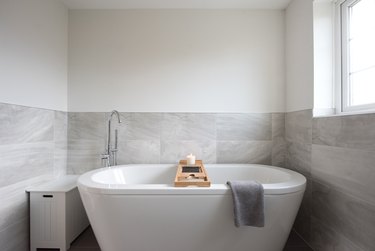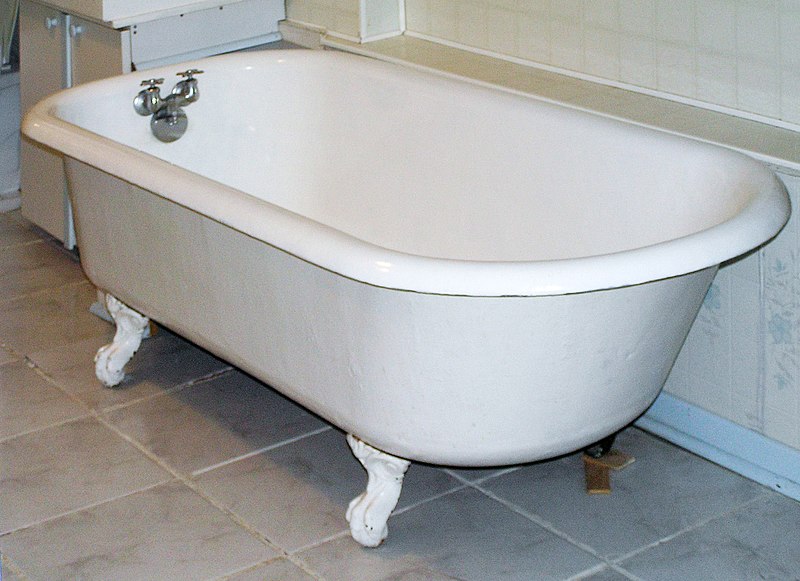Can I Set Up a Bathtub Myself? Factors to Consider As Well As Steps
Can I Set Up a Bathtub Myself? Factors to Consider As Well As Steps
Blog Article
They are making several good points relating to How to Install a Bathtub: Install an Acrylic Tub and Tub Surround in general in this great article following next.

Setting up a bath tub isn't exactly rocket science, yet it does require solid plumbing, woodworking, and also sometimes, tiling skills. Changing an old bath tub with a new one is additionally a moderately challenging task. If the old bathtub is readily easily accessible, the task can relocate quickly; if you have to open up a wall surface to remove the old tub as well as place the brand-new bath tub, the task is much harder. In either situation, the job is within a residence handyman's abilities, although you will need a helper to leave the old bathtub and also embeded in the new one. Ensure you have qualified yourself for the task and also fit trying it. Rather than hiring a professional to take over a halfway-completed project, it is much better to think about utilizing one prior to you start. Opportunities are you might require a specialist plumber to make tube links.
This short article will assist you set up a new tub in your shower room if you have already purchased a new tub as well as don't need to alter the arrangement of your previous supply of water pipes.
Your tools and material checklist should comprise the following:
Removing Old Taps
If you need to replace old faucets with brand-new ones as a part of your installment, then the first thing you should do is disconnect the water. After doing so, activate the faucets to drain pipes any type of water staying in the system. The process of removing the existing faucets can be fairly troublesome because of the restricted access that is often the instance.
Make use of a container wrench (crowsfoot spanner) or a tap tool to reverse the nut that links the supply pipes to the taps. Have a towel all set for the staying water that will come from the pipelines. When the supply pipes have been gotten rid of, utilize the exact same tool to loosen up the nut that holds the taps onto the bath/basin. You will require to quit the single faucets from transforming during this process. As soon as the taps have been gotten rid of, the holes in the bath/basin will certainly have to be cleansed of any type of old sealing substance.
Prior to proceeding to fit the brand-new faucets, compare the pipeline connections on the old taps to the brand-new taps. If the old taps are longer than the brand-new taps, after that a shank adapter is needed for the new faucets to fit.
Fitting New Touches
If the tails of the brand-new taps are plastic, after that you will require a plastic port to prevent damages to the thread. One end of the adapter fits on the plastic tail of the faucet and the various other end offers a link to the existing supply pipes.
If you require to fit a monobloc, then you will certainly require lowering couplers, which connects the 10mm pipeline of the monobloc to the conventional 15mm supply pipeline.
Next, place the tap in the mounting hole in the bath/basin ensuring that the washers remain in location in between the tap and also the sink. Protect the faucet in place with the producer given backnut. Once the faucet is firmly in place, the supply pipelines can be attached to the tails of the taps. The taps can either be attached by using corrugated copper piping or with typical faucet connectors. The previous type must be connected to the tap finishes first, tightening up just by hand. The supply pipes can later on be connected to the various other end. Tighten up both ends with a spanner after both ends have been linked.
Mounting the Bathtub
Utilizing both wood boards under its feet, place the bathtub in the required setting. The wood boards are handy in evenly spreading the weight of the tub over the location of the boards instead of focusing all the weight onto four little factors.
The following goal is to guarantee that the bathtub is leveled all round. This can be accomplished by examining the level and adjusting the feet on the bathtub up until the level reviews degree.
To mount taps, fit the bottom of the furthest versatile tap port to the proper supply pipeline by making a compression sign up with; after that do the same for the other tap.
Switch on the supply of water and check all joints as well as brand-new pipework for leakages and also tighten them if necessary. Fill the tub as well as additionally examine the overflow outlet and the normal outlet for leaks.
Finally, repair the bath paneling as described in the producer's instruction manual. Tiling and sealing around the bathtub should wait until the bathtub has been made use of at the very least when as this will certainly resolve it right into its last setting.
Getting ready for the Setup
Firstly, the supporting frame provided with the bathroom must be fitted (if needed) according to the maker's directions. Next off, fit the faucets or mixer to the bath tub. When suitable the faucet block, it is necessary to see to it that if the faucet includes a plastic washing machine, it is fitted in between the bathroom as well as the taps. On a plastic bath, it is also reasonable to fit a sustaining plate under the faucets system to prevent pressure on the bath tub.
Fit the versatile tap connectors to the bottom of both faucets utilizing 2 nuts and olives (occasionally provided with the tub). Fit the plug-hole outlet by smearing mastic filler round the sink electrical outlet opening, and after that pass the outlet via the hole in the bath. Use the nut provided by the maker to fit the plug-hole. Analyze the plug-hole outlet for an inlet on the side for the overflow pipeline.
Next, fit the end of the versatile overflow pipeline to the overflow outlet. After that, screw the pipe to the overflow face which need to be fitted inside the bathroom. Ensure you use every one of the provided washers.
Connect the catch to the bottom of the waste electrical outlet on the tub by winding the thread of the waste electrical outlet with silicone mastic or PTFE tape, as well as screw on the catch to the electrical outlet. Connect all-time low of the overflow tube in a similar manner.The bathroom must now prepare to be fitted in its last setting.
Tiling Around the Bathtub
In the location where the bath fulfills the tile, it is essential to seal the accompanies a silicone rubber caulking. This is very important as the fitting can relocate enough to split a rigid seal, creating the water to penetrate the wall surface between the bathroom and the tiling, bring about problems with wetness as well as feasible leaks to the ceiling listed below.
You can choose from a range of coloured sealants to assimilate your components as well as installations. They are sold in tubes and also cartridges, and can securing spaces approximately a width of 3mm (1/8 inch). If you have a bigger gap to fill up, you can load it with twists of drenched paper or soft rope. Remember to constantly fill the tub with water prior to sealing, to allow for the motion experienced when the bathtub is in usage. The sealant can fracture fairly very early if you do not consider this activity before securing.
Alternatively, ceramic coving or quadrant ceramic tiles can be made use of to edge the bathroom or shower tray. Plastic strips of coving, which are easy to use and reduce to size, are likewise conveniently available on the marketplace. It is advisable to fit the ceramic tiles making use of water-resistant or water resistant glue and also grout.
Bathtub Installation
How Important Is A Bathtub To Your Home?
High-quality baths, showers, and other bathroom updates are necessary when considering a smart investment in your home. It’s a room that you go to every day and one that is constantly being used by guests.The bathroom is one of the top trafficked rooms in a home and also one of the most valuable in terms of home resale.
Install Piping Before Tub
You will be using your existing drain and waste vent system, but pipes required include the hot and cold water supply lines and a pipe leading to a shower head. A mixing valve and shower head are also needed. Air chambers may be required.
Position the Tub
Lower the tub into place so that the continuous flange fits against the wall studs and rests on 1’x4' or 2’x4' supports. Anchor the tub to the enclosure with nails or screws inserted through the flanges into the studs.
NOTE: Remember, bathtubs and shower stalls may require support framing. A bathtub filled with water is extremely heavy, so check building codes and framing support before installing the tub.
Assemble Drain Connections
Assemble the bathtub drain connections by connecting the tub overflow with the tub drain above the trap, not beyond it. The trap will have a compression fitting that screws over the arm of the overflow assembly.
Place a Pipe For the Shower Head
First, locate a brass female threaded winged fitting and attach it to a framing support via a screw or a nail. Then run a pipe up the wall for the shower head. Sweat or solder the other side of the brass fitting to the top of the pipe.
Attaching Hot and Cold Water Lines
Attach your water lines for both hot and cold by sweating these directly into the hot and cold ports of the mixing valve. The mixing valve will be how water enters the tub’s system, not by the pipes themselves.
Install the Spout
Extend a piece of 1/2 inch pipe, or whichever length is specified in the manufacturer’s instructions, for the tub spout. Sweat on a male threaded fitting at the end of the pipe or use a brass nipple of the proper length and a 1/2 inch cap.
NOTE: At this point you should have your rough-in plumbing work inspected before proceeding further.
Check For Leaks
Restore the water pressure and check the drain connection and the supply pipes for any sign of leaking.
estore the Bathroom Wall
Replace the wall with moisture-resistant drywall as a base for your wall covering. Seal the joints between the wall and your new tub with silicone caulk as protection against water seepage.
https://www.berkeys.com/2016/12/02/bathtub-installation-dallas/

I'm very focused on How to Install a Bathtub and I am praying you enjoyed reading our piece. Loved our blog? Please share it. Help somebody else discover it. We value reading our article about Installing A Bathtub.
Go Services
Report this page